Unit6 Topic 1 There is a study next to my bedroom. Section B 表格式教学设计
文档属性
| 名称 | Unit6 Topic 1 There is a study next to my bedroom. Section B 表格式教学设计 | 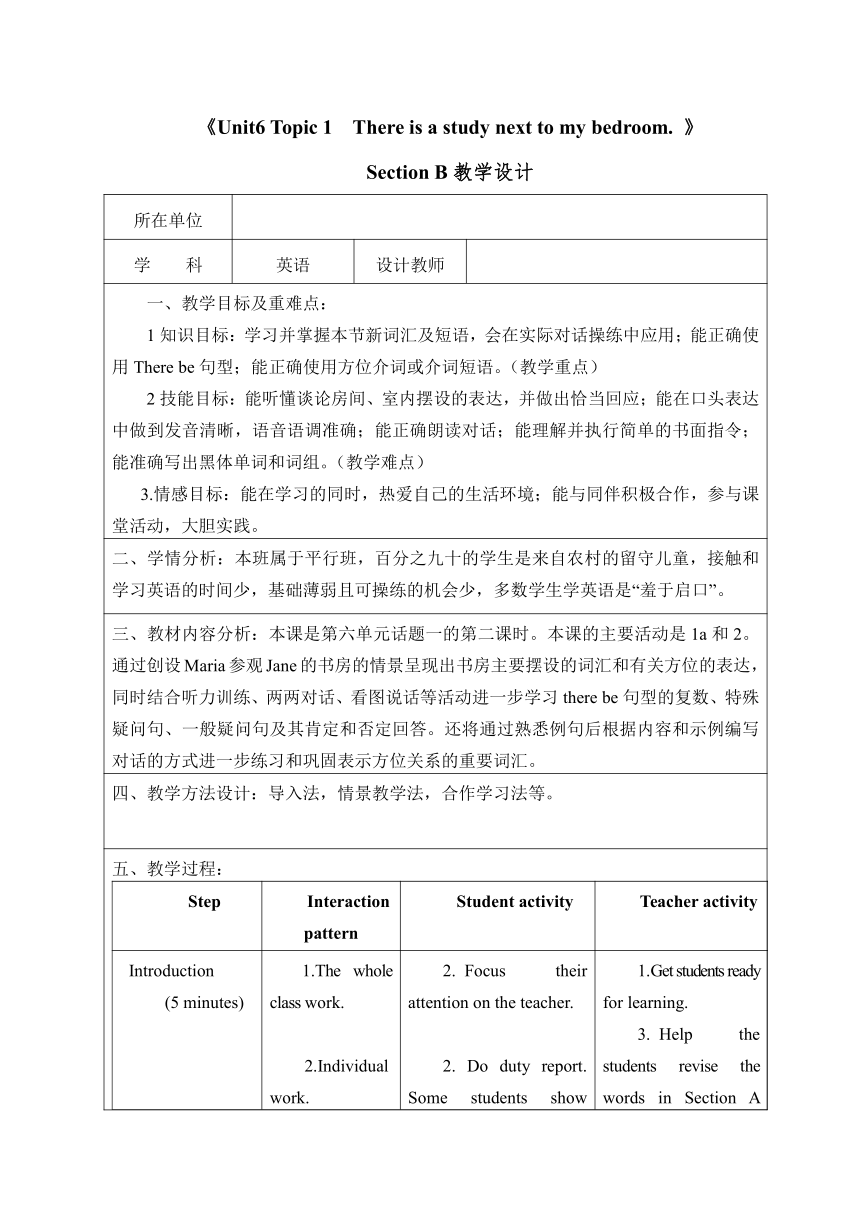 | |
| 格式 | docx | ||
| 文件大小 | 32.8KB | ||
| 资源类型 | 教案 | ||
| 版本资源 | 仁爱科普版 | ||
| 科目 | 英语 | ||
| 更新时间 | 2022-01-25 12:24:58 | ||
图片预览

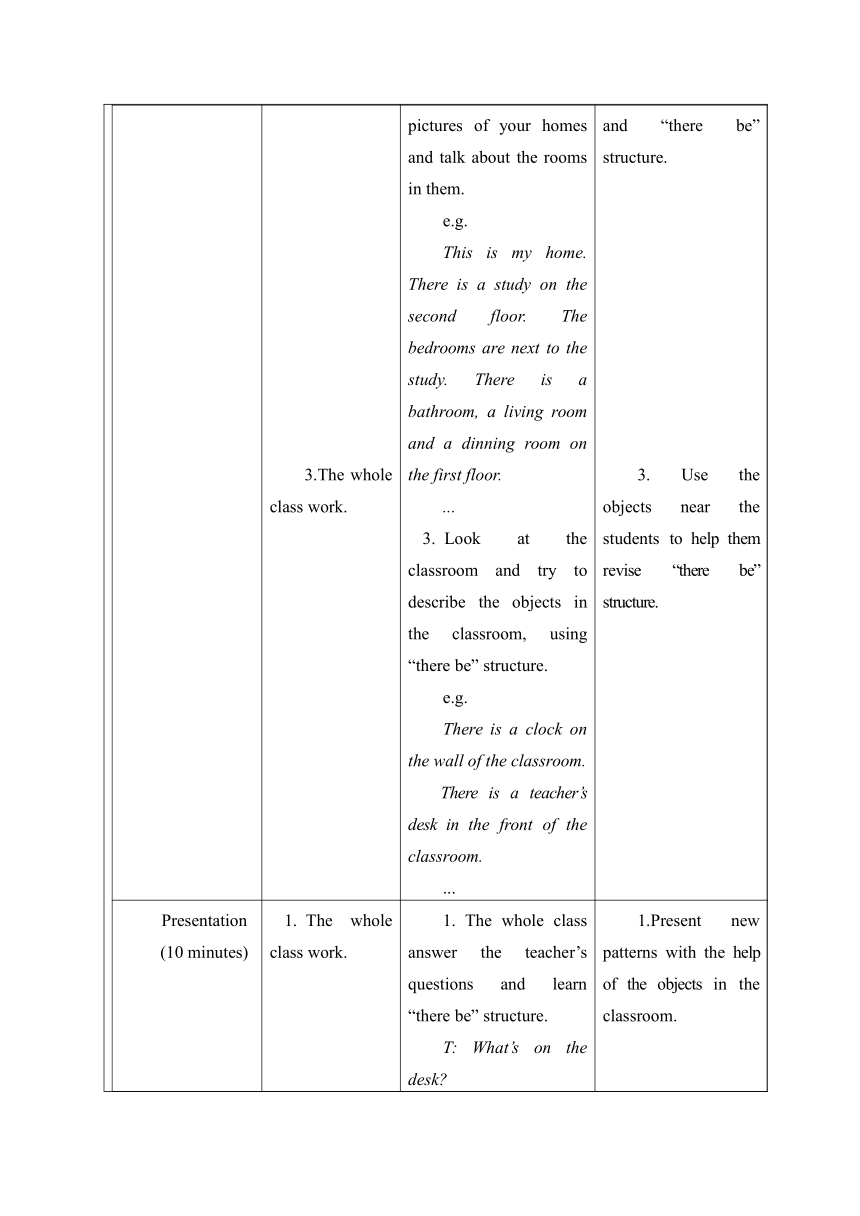
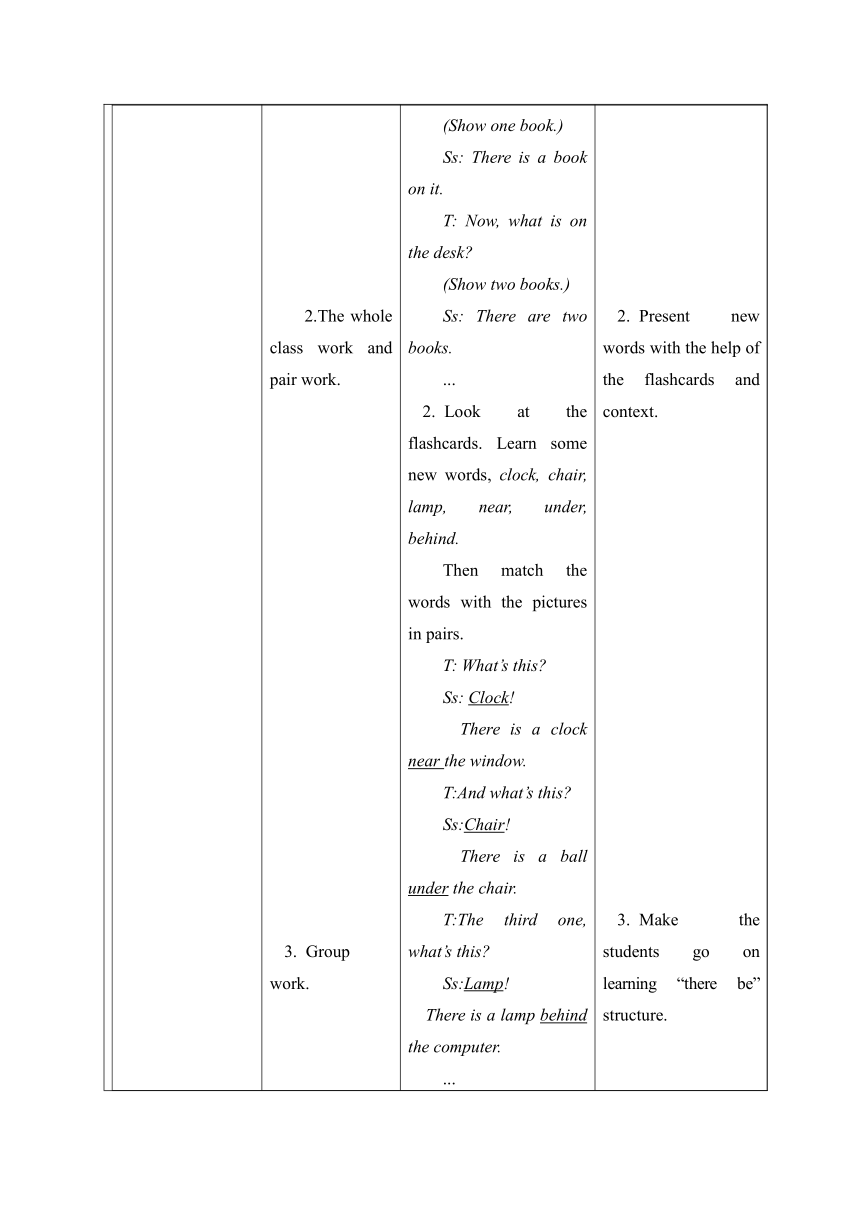
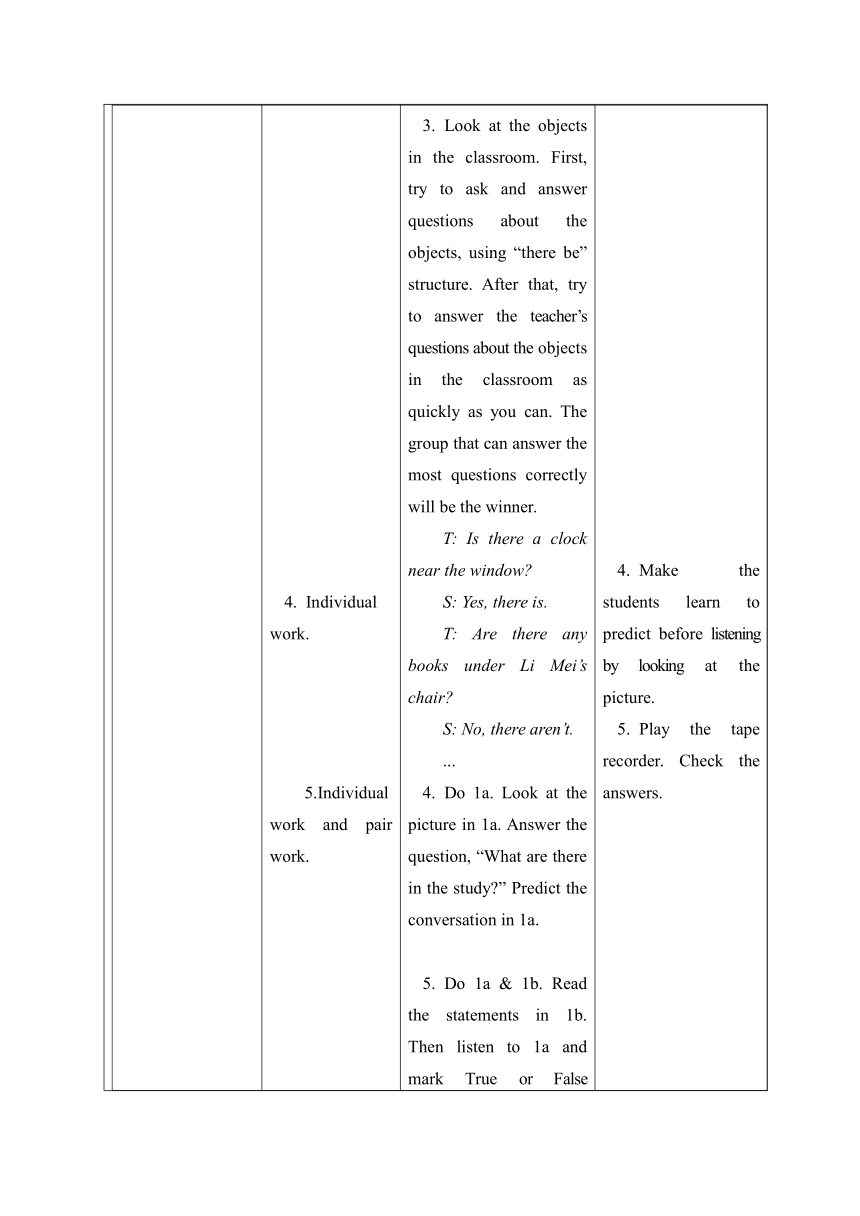
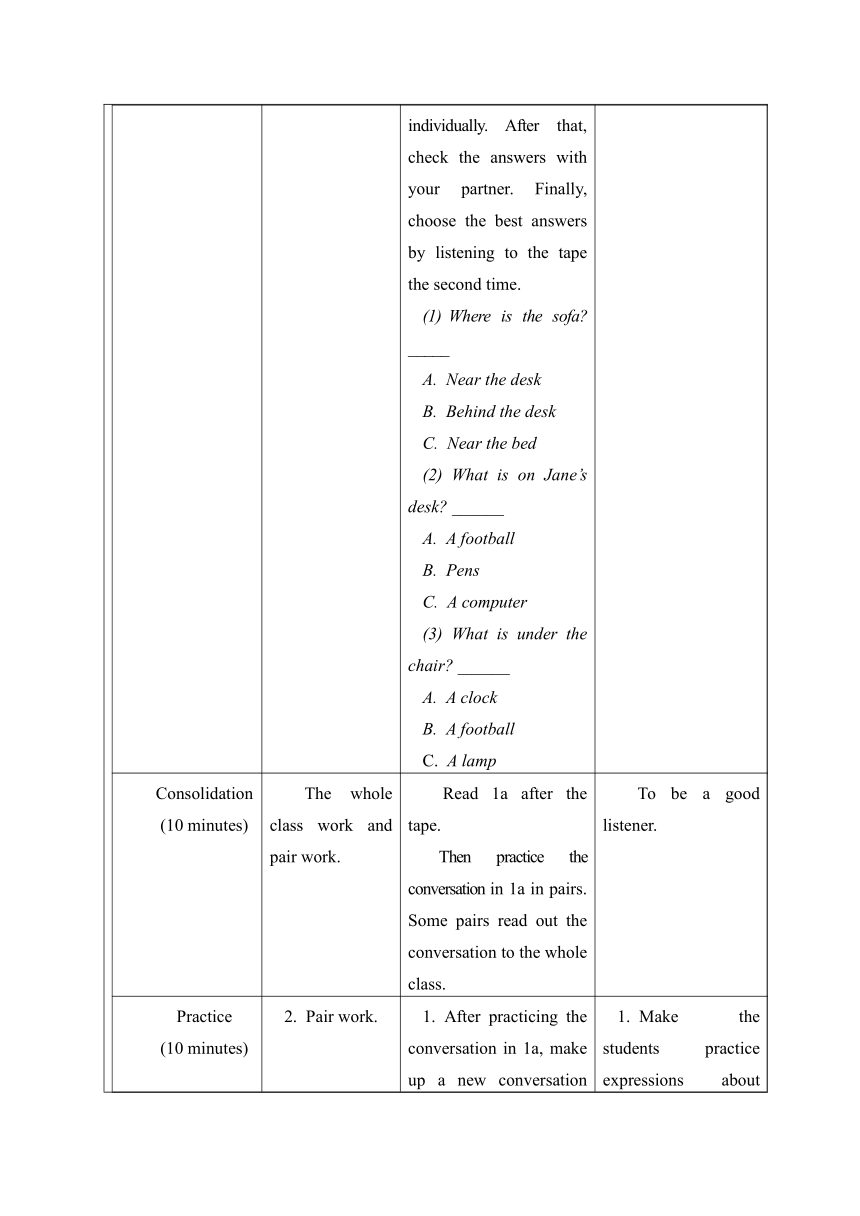
文档简介
《Unit6 Topic 1 There is a study next to my bedroom. 》
Section B教学设计
所在单位
学 科 英语 设计教师
教学目标及重难点: 1知识目标:学习并掌握本节新词汇及短语,会在实际对话操练中应用;能正确使用There be句型;能正确使用方位介词或介词短语。(教学重点) 2技能目标:能听懂谈论房间、室内摆设的表达,并做出恰当回应;能在口头表达中做到发音清晰,语音语调准确;能正确朗读对话;能理解并执行简单的书面指令;能准确写出黑体单词和词组。(教学难点) 3.情感目标:能在学习的同时,热爱自己的生活环境;能与同伴积极合作,参与课堂活动,大胆实践。
二、学情分析:本班属于平行班,百分之九十的学生是来自农村的留守儿童,接触和学习英语的时间少,基础薄弱且可操练的机会少,多数学生学英语是“羞于启口”。
三、教材内容分析:本课是第六单元话题一的第二课时。本课的主要活动是1a和2。通过创设Maria参观Jane的书房的情景呈现出书房主要摆设的词汇和有关方位的表达,同时结合听力训练、两两对话、看图说话等活动进一步学习there be句型的复数、特殊疑问句、一般疑问句及其肯定和否定回答。还将通过熟悉例句后根据内容和示例编写对话的方式进一步练习和巩固表示方位关系的重要词汇。
四、教学方法设计:导入法,情景教学法,合作学习法等。
五、教学过程: StepInteraction patternStudent activityTeacher activityIntroduction (5 minutes)The whole class work. Individual work. 3.The whole class work. Focus their attention on the teacher. 2. Do duty report. Some students show pictures of your homes and talk about the rooms in them. e.g. This is my home. There is a study on the second floor. The bedrooms are next to the study. There is a bathroom, a living room and a dinning room on the first floor. ... Look at the classroom and try to describe the objects in the classroom, using “there be” structure. e.g. There is a clock on the wall of the classroom. There is a teacher’s desk in the front of the classroom. ...1.Get students ready for learning. Help the students revise the words in Section A and “there be” structure. 3. Use the objects near the students to help them revise “there be” structure.Presentation (10 minutes)The whole class work. 2.The whole class work and pair work. Group work. Individual work. 5.Individual work and pair work.1. The whole class answer the teacher’s questions and learn “there be” structure. T: What’s on the desk (Show one book.) Ss: There is a book on it. T: Now, what is on the desk (Show two books.) Ss: There are two books. ... Look at the flashcards. Learn some new words, clock, chair, lamp, near, under, behind. Then match the words with the pictures in pairs. T: What’s this Ss: Clock! There is a clock near the window. T:And what’s this Ss:Chair! There is a ball under the chair. T:The third one, what’s this Ss:Lamp! There is a lamp behind the computer. ... Look at the objects in the classroom. First, try to ask and answer questions about the objects, using “there be” structure. After that, try to answer the teacher’s questions about the objects in the classroom as quickly as you can. The group that can answer the most questions correctly will be the winner. T: Is there a clock near the window S: Yes, there is. T: Are there any books under Li Mei’s chair S: No, there aren’t. ... Do 1a. Look at the picture in 1a. Answer the question, “What are there in the study ” Predict the conversation in 1a. Do 1a & 1b. Read the statements in 1b. Then listen to 1a and mark True or False individually. After that, check the answers with your partner. Finally, choose the best answers by listening to the tape the second time. Where is the sofa _____ Near the desk Behind the desk Near the bed What is on Jane’s desk ______ A football Pens A computer What is under the chair ______ A clock A football A lamp1.Present new patterns with the help of the objects in the classroom. Present new words with the help of the flashcards and context. Make the students go on learning “there be” structure. Make the students learn to predict before listening by looking at the picture. Play the tape recorder. Check the answers. Consolidation (10 minutes)The whole class work and pair work. Read 1a after the tape. Then practice the conversation in 1a in pairs. Some pairs read out the conversation to the whole class.To be a good listener. Practice (10 minutes)Pair work. The whole class work and pair work. Individual work and pair work.After practicing the conversation in 1a, make up a new conversation about the study, bedroom, living room or other rooms in your home in pairs. Then practice your new conversation with your partner. After that, some pairs act out your conversation to the whole class. e.g. A: Where is your study B: It is on the second floor of my home. A: Is there a computer in your study B: Yes, there is. It is on the desk. A:Are there any flowers in your study B:Yes, there are. I like flowers. A: What’s under the desk B: There is a football. ... 2.Do 2. Look at the pictures in 2. Answer the teacher’s questions to learn some new words and phrase, in front of, guitar, window. T: What can you see in Picture 1 Ss: Tree and classroom. T: Yes. We can say, there is a tree in front of the classroom. What can you see in Picture 2 Ss:Two students and classroom. T:Yes. There are two students in the front of the classroom. What can you see in Picture 3 ... Then ask and answer questions about the other pictures in 2 in pairs. After that, some pairs act out the conversations. e.g. A:What’s near the window B: There is a guitar near the window. A: Is there a clock near the guitar B: No, there isn’t. ... 3.Do 3. Look at the pictures in 3. Learn the words and phrases table, key, put away, door, look after, thing. Fill in the blanks to complete the conversations individually. Then listen and check the answers. Practice the conversations in pairs. After that, some pairs act out your conversations to the whole class.Make the students practice expressions about positions and existence, rooms in homes, furniture and home items. Create situations to present the new words and phrases. Make the students practice the “there be” structure orally. 3.Make the students practice the expressions in this section.Production (10 minutes)Group work. Work in groups. Discuss with your group members about what your ideal study or bedroom is like. Then draw them on the paper. Show your pictures to the whole class and try to introduce them to other students. e.g. This is our ideal study. There is a computer on the desk, of course. There is a guitar on the wall because we like playing the guitar. There is a football under the table. We often play football after class. ...Make the students use the expressions about “there be” structure in oral work and written work after learning. Assign the homework: Review the words and practice the conversations in 1a with your partner; Go on writing your ideal room. Then report it to the class next day; Preview Section C.Teaching reflection: 在本课中,学生通过听力训练、师生问答、小组合作等活动,结合教学闪卡等教具,学习并反复操练了关于there be的表达法及其提问:“What’s ... ”。在这节课中,明显发现学生对于in front of和in the front of容易混淆,导致错误使用。因此,教师应多创设真实的情景,比如运用图片,或者结合身边真实的语言环境,引导学生直观地感受这两个词组的区别,避免混淆。
六、板书设计: Unit6 Topic 1 There is a study next to my bedroom. Section B 1.Are there any English books in your study lamp clock 2.Is there a computer in your study near under 3.What’s on your desk chair behind 4.There’s a tree in front of the classroom. front in front of 5.There are two students in the front of the classroom. guitar window 6.Put them away, please. table key 7.You must look after your things. put away put away door look after thing
七、技术运用:多媒体,PPT幻灯片
八、资源引用:多媒体视频音频文件
九、创新点:
十、教学反思:在本课中,学生通过听力训练、师生问答、小组合作等活动,结合教学闪卡等教具,学习并反复操练了关于there be的表达法及其提问:“What’s ... ”。在这节课中,明显发现学生对于in front of和in the front of容易混淆,导致错误使用。因此,教师应多创设真实的情景,比如运用图片,或者结合身边真实的语言环境,引导学生直观地感受这两个词组的区别,避免混淆。
Section B教学设计
所在单位
学 科 英语 设计教师
教学目标及重难点: 1知识目标:学习并掌握本节新词汇及短语,会在实际对话操练中应用;能正确使用There be句型;能正确使用方位介词或介词短语。(教学重点) 2技能目标:能听懂谈论房间、室内摆设的表达,并做出恰当回应;能在口头表达中做到发音清晰,语音语调准确;能正确朗读对话;能理解并执行简单的书面指令;能准确写出黑体单词和词组。(教学难点) 3.情感目标:能在学习的同时,热爱自己的生活环境;能与同伴积极合作,参与课堂活动,大胆实践。
二、学情分析:本班属于平行班,百分之九十的学生是来自农村的留守儿童,接触和学习英语的时间少,基础薄弱且可操练的机会少,多数学生学英语是“羞于启口”。
三、教材内容分析:本课是第六单元话题一的第二课时。本课的主要活动是1a和2。通过创设Maria参观Jane的书房的情景呈现出书房主要摆设的词汇和有关方位的表达,同时结合听力训练、两两对话、看图说话等活动进一步学习there be句型的复数、特殊疑问句、一般疑问句及其肯定和否定回答。还将通过熟悉例句后根据内容和示例编写对话的方式进一步练习和巩固表示方位关系的重要词汇。
四、教学方法设计:导入法,情景教学法,合作学习法等。
五、教学过程: StepInteraction patternStudent activityTeacher activityIntroduction (5 minutes)The whole class work. Individual work. 3.The whole class work. Focus their attention on the teacher. 2. Do duty report. Some students show pictures of your homes and talk about the rooms in them. e.g. This is my home. There is a study on the second floor. The bedrooms are next to the study. There is a bathroom, a living room and a dinning room on the first floor. ... Look at the classroom and try to describe the objects in the classroom, using “there be” structure. e.g. There is a clock on the wall of the classroom. There is a teacher’s desk in the front of the classroom. ...1.Get students ready for learning. Help the students revise the words in Section A and “there be” structure. 3. Use the objects near the students to help them revise “there be” structure.Presentation (10 minutes)The whole class work. 2.The whole class work and pair work. Group work. Individual work. 5.Individual work and pair work.1. The whole class answer the teacher’s questions and learn “there be” structure. T: What’s on the desk (Show one book.) Ss: There is a book on it. T: Now, what is on the desk (Show two books.) Ss: There are two books. ... Look at the flashcards. Learn some new words, clock, chair, lamp, near, under, behind. Then match the words with the pictures in pairs. T: What’s this Ss: Clock! There is a clock near the window. T:And what’s this Ss:Chair! There is a ball under the chair. T:The third one, what’s this Ss:Lamp! There is a lamp behind the computer. ... Look at the objects in the classroom. First, try to ask and answer questions about the objects, using “there be” structure. After that, try to answer the teacher’s questions about the objects in the classroom as quickly as you can. The group that can answer the most questions correctly will be the winner. T: Is there a clock near the window S: Yes, there is. T: Are there any books under Li Mei’s chair S: No, there aren’t. ... Do 1a. Look at the picture in 1a. Answer the question, “What are there in the study ” Predict the conversation in 1a. Do 1a & 1b. Read the statements in 1b. Then listen to 1a and mark True or False individually. After that, check the answers with your partner. Finally, choose the best answers by listening to the tape the second time. Where is the sofa _____ Near the desk Behind the desk Near the bed What is on Jane’s desk ______ A football Pens A computer What is under the chair ______ A clock A football A lamp1.Present new patterns with the help of the objects in the classroom. Present new words with the help of the flashcards and context. Make the students go on learning “there be” structure. Make the students learn to predict before listening by looking at the picture. Play the tape recorder. Check the answers. Consolidation (10 minutes)The whole class work and pair work. Read 1a after the tape. Then practice the conversation in 1a in pairs. Some pairs read out the conversation to the whole class.To be a good listener. Practice (10 minutes)Pair work. The whole class work and pair work. Individual work and pair work.After practicing the conversation in 1a, make up a new conversation about the study, bedroom, living room or other rooms in your home in pairs. Then practice your new conversation with your partner. After that, some pairs act out your conversation to the whole class. e.g. A: Where is your study B: It is on the second floor of my home. A: Is there a computer in your study B: Yes, there is. It is on the desk. A:Are there any flowers in your study B:Yes, there are. I like flowers. A: What’s under the desk B: There is a football. ... 2.Do 2. Look at the pictures in 2. Answer the teacher’s questions to learn some new words and phrase, in front of, guitar, window. T: What can you see in Picture 1 Ss: Tree and classroom. T: Yes. We can say, there is a tree in front of the classroom. What can you see in Picture 2 Ss:Two students and classroom. T:Yes. There are two students in the front of the classroom. What can you see in Picture 3 ... Then ask and answer questions about the other pictures in 2 in pairs. After that, some pairs act out the conversations. e.g. A:What’s near the window B: There is a guitar near the window. A: Is there a clock near the guitar B: No, there isn’t. ... 3.Do 3. Look at the pictures in 3. Learn the words and phrases table, key, put away, door, look after, thing. Fill in the blanks to complete the conversations individually. Then listen and check the answers. Practice the conversations in pairs. After that, some pairs act out your conversations to the whole class.Make the students practice expressions about positions and existence, rooms in homes, furniture and home items. Create situations to present the new words and phrases. Make the students practice the “there be” structure orally. 3.Make the students practice the expressions in this section.Production (10 minutes)Group work. Work in groups. Discuss with your group members about what your ideal study or bedroom is like. Then draw them on the paper. Show your pictures to the whole class and try to introduce them to other students. e.g. This is our ideal study. There is a computer on the desk, of course. There is a guitar on the wall because we like playing the guitar. There is a football under the table. We often play football after class. ...Make the students use the expressions about “there be” structure in oral work and written work after learning. Assign the homework: Review the words and practice the conversations in 1a with your partner; Go on writing your ideal room. Then report it to the class next day; Preview Section C.Teaching reflection: 在本课中,学生通过听力训练、师生问答、小组合作等活动,结合教学闪卡等教具,学习并反复操练了关于there be的表达法及其提问:“What’s ... ”。在这节课中,明显发现学生对于in front of和in the front of容易混淆,导致错误使用。因此,教师应多创设真实的情景,比如运用图片,或者结合身边真实的语言环境,引导学生直观地感受这两个词组的区别,避免混淆。
六、板书设计: Unit6 Topic 1 There is a study next to my bedroom. Section B 1.Are there any English books in your study lamp clock 2.Is there a computer in your study near under 3.What’s on your desk chair behind 4.There’s a tree in front of the classroom. front in front of 5.There are two students in the front of the classroom. guitar window 6.Put them away, please. table key 7.You must look after your things. put away put away door look after thing
七、技术运用:多媒体,PPT幻灯片
八、资源引用:多媒体视频音频文件
九、创新点:
十、教学反思:在本课中,学生通过听力训练、师生问答、小组合作等活动,结合教学闪卡等教具,学习并反复操练了关于there be的表达法及其提问:“What’s ... ”。在这节课中,明显发现学生对于in front of和in the front of容易混淆,导致错误使用。因此,教师应多创设真实的情景,比如运用图片,或者结合身边真实的语言环境,引导学生直观地感受这两个词组的区别,避免混淆。
同课章节目录
- Unit 5 Our school life
- Topic 1 I usually come to school by subway.
- Topic 2 A few students are running around the play
- Topic 3 My school life is very interesting.
- Unit 6 Our local area
- Topic 1 Is there a computer in your study?
- Topic 2 My home is in an apartment building.
- Topic 3 Which is the way to the hospital?
- Review of Units 5-6
- Unit 7 The Birthday
- Topic 1 When is your birthday?
- Topic 2 Can you sing an English song?
- Topic 3 Everyone had a good time.
- Unit 8 The seasons and the Weathe
- Topic 1 What's the weather like in summer?
- Topic 2 The summer holidays are coming.
- Topic 3 Let’s celebrate!
- Review of Units 7-8
- 旧版资料
- Unit 5 Our School Life
- Unit 6 Our Local Area
- Unit 7 The Birthday
- Unit 8 The seasons and the Weathe
- Unit 7 Celebrating the Birthday(老版本)
